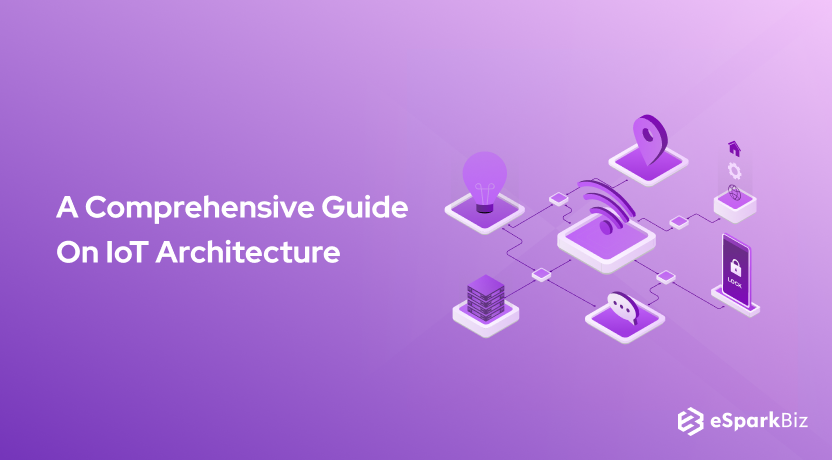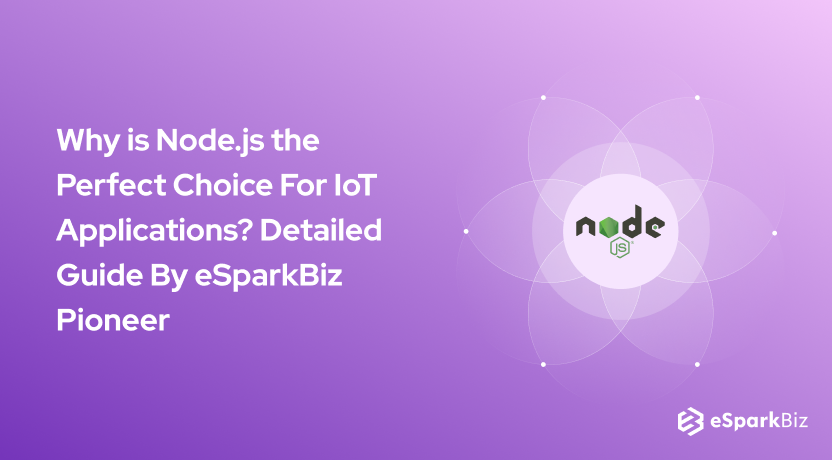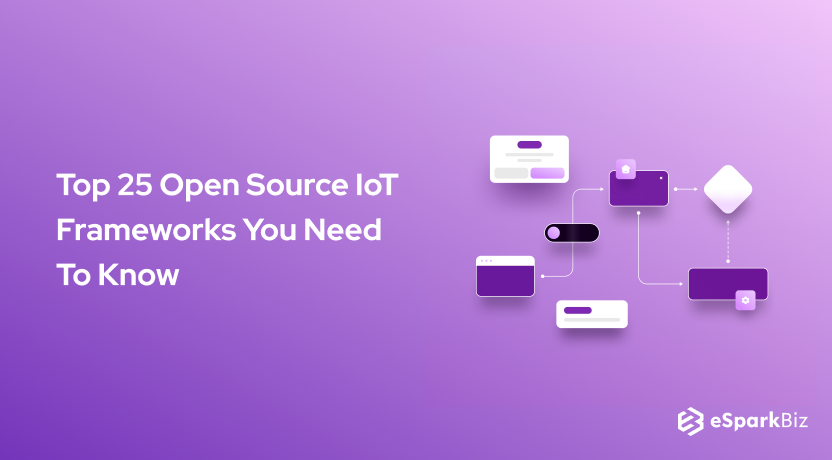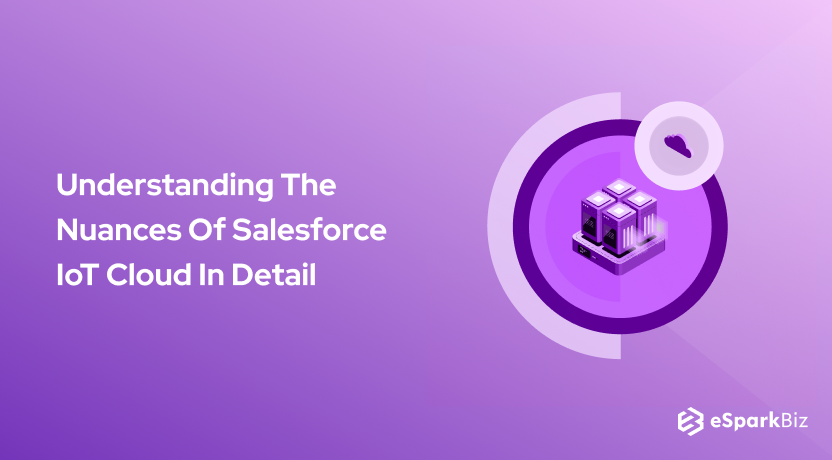In the current world, technological advancement has opened many doors and itself has undergone a lot of changes. Nowadays, a person can use the internet to control and monitor regular everyday appliances as well. Today, we will talk about IoT Architecture in detail.
These include things like the thermostat, kitchen gadgets, baby monitors, cars, etc., for better living conditions. The key contributor to this is the Internet of Things, also referred to as the IoT.
This connection has been instrumental in improving the lifestyle of the common man, with scanty human intervention. Any iot app development company can help you to develop such high-end solutions.
There are many aspects that affect the IoT Architecture like analytics, big data, computing, etc., at a low cost. With this help, the connection between human life and the digital world is more interconnected.
People can easily use these technologies to monitor and adjust their everyday things, and live comfortably. Web development plays a role in this regard and keeps changing IoT functionality for the better.
What Is IoT Architecture?

It is true that the IoT includes a vast minefield of resources that make a product more advanced and useful. Thus, many of the businesses and other such organizations want to create Software products using this technology.
The IoT Architecture is not as simple as it seems, however, given the many conditions and devices that come into play. Plus, there are many IoT applications too and each comes with their own rules of usage.
Therefore, when you are beginning to frame the IoT Architecture Diagram, you should consider which solutions may provide the best effectiveness.
This would significantly reduce your time and effort, and make the process easier to handle. Plus, you do not have to worry about using a vast majority of resources either. Yet, whatever procedure newer developers follow for this, they need to understand the elements better first.
In this regard, there are some factors that you need to pay close attention to for software integration. This is crucial for the Internet of Things (IoT) Architecture for Beginners as the -process of doing so is not the easiest.
This is especially true in terms of the practical side, which is complicated and nuanced. For a better and more efficient formulation, taking the help of professional developers would greatly benefit you.
The basic elements regarding the IoT Architecture that you would work with are layers, sensors, cloud services, protocols, and actuators. Altogether, they perform the four main stages of the building process and are important elements in the diagram.
To utilize each of the elements in a systematic manner and to create a unified network, the four stages work simultaneously.
But first, it is important to divide, understand, and monitor the different layers of IoT Architecture. There are three in total.
Different Layers Of IoT Architecture
1. IoT Device Layer (perspective of the clients)
2. IoT Gateway Layer (perspective of the server operators)
3. IoT Platform Layer (the path that connects the server operators and the clients)
Thus, when you are creating the IoT Architectures, you should focus on each of the layers and their reasons. After you do so, you can properly and effectively understand what you need to concentrate on more.
For creating the correct software, it is important to remain consistent with combining the layers and the stages well.
Of course, there are some basic points you should address too, to produce a reliable Internet of Things Architecture. Such features one should consider are availability, functionality, maintainability, and scalability.
While creating the architecture diagram and even in the prior planning period, you should take note of these. Overall, careful observation and understanding of the entire process and stages first would improve your product development.
Basic Elements Of IoT Architecture
There are some particular elements that are present in the IoT Architecture Diagram that enable the entire functionality.
These building blocks are necessary for collecting, processing, and storing the data that works behind-the-scenes of the IoT process.
Things
This signifies an object that has sensors and collects the transferable data and the actuators that allow changes to occur in the physical functions.
The usual materials that are associated with this are street lamps, fridges, buildings, production machinery, vehicles, and much more. However, the sensors are not always connected physically with these things.
Gateways
An important part of the IoT Architecture Diagram is the gateways, which acts as the connection between the data center and the things. The data passes through it, and filtering and data processing occur to the data during the transfer.
Streaming Data Processor
This makes sure that the input data securely enters the control applications and the data lake.
Cloud Gateways
These gateways allow the data to move through the field gateways to the cloud IoT servers securely and compressed. It also contacts the field gateways through protocols and sees if the data is compatible.
Data Analytics
To gain actionable insights and trends, the data analysts notice the patterns and correlations of the gathered data. After that, they create algorithms for better applications.
Big Data Warehouse
The unfiltered data from the data lake enters this warehouse, which are needed for meaningful insights. Plus, this element of IoT Architecture also holds the commands from control applications and context information regarding sensors and things.
Data Lake
When the big data enters in ‘streams’ and ‘batches’, it can stay here in its original form.
Machine Learning & Its Models
In order to create more efficient control application models, it is important to understand and test the machines. Based on the data information gathered, these models are updated, mostly in a monthly format.
User Applications
This element of the IoT Architecture allows the users to directly connect to the IoT devices and control options. They can monitor the things, set automatic tasks, and send commands through the network connection.
Control Applications
The machine-learning-based or rule-based control applications send alerts and commands to actuators. For example, the control applications of a smart home have weather detection functions.
When the weather forecasts show stormy weather ahead, the control applications can send commands to the window to shut automatically.
While these are automated parts in the IoT Architecture, a level of user-control is important for emergencies.
Main Stages Of IoT Architectures
There are some specific stages that are present in regards to the Internet of Things Architecture. These are as follows.
- Actuators and sensors
- Systems for Data Acquisition and internet gateways
- Edge IT system
- Cloud and Data Center
For a better understanding of each stage, read through them in detail in the following points:

Stage 1: Networked Things
The first stage of the IoT Architecture includes the actuators and the sensors and their functions with data collection.
These two elements focus on covering the basics of the necessities of this technology in the physical world. After properly covering and analyzing the factors, these two components figure out what to follow with.
To specify, sensors do the important task of gathering the information they received in the physical world.
Then, it converts this into data, and that makes it easier to utilize it during the processing period. Owing to this important task, it is the first step in this stage of the IoT Architecture Diagram.
The next is actuators, which help the process to go one step further. To put it simply, these allow the software to develop into the physical world and carry out the device functions.
It can alter the physical conditions that produce the data and is important to the Open Source IoT frameworks. For example, the valve for airflow can adjust, the power supply can turn off, or the temperature can modify because of actuators.
Altogether, they cover a variety of different devices, like robotic cameras, accelerometers, heart-rate monitors, sensors for air quality, and legacy industrial objects.
The Importance Of Sensors In IoT Architecture
With the help of the sensors as well as the actuators in the IoT Architecture, IoT systems are evolving at a constant place.
The scope, too, is getting broader, with the help of the wireless sensor technologies. These include wireless technologies for network and the Power over Ethernet technology.
Indeed, with the support of these factors, the devices that used to work through a wired LAN connection do not need an A/C power source to operate. Of course, it is important to mention that such data processing is not limited to one stage of IoT Architecture.
While choosing and using the sensors, it is also important to note that the power of processing is different for each device.
Data processing is the most significant aspect of the architectural diagram of the IoT. And because of that, you should select the insight depth and immediacy carefully before this can begin. You should enable the processing near the end of the devices if you need the information immediately.
To get more deep into the processing, you need to consider the IoT Cloud Architecture more carefully. You should transfer the data to such a system as they can get many data sources together.
You need to adjust the processing closer to the sensors in case of more high-octane and fast-response-time oriented devices. These include products that are needed during surgery or for accident prevention.
Stage 2: Sensor Data Aggregation System
At this stage of the Internet of Things Architecture, you are not going much further than the first step. But the main elements of concern here are data acquisition systems (DAS) and internet gateways.
To simplify, the former focuses on connecting to the aggregate output and the sensor network. On the other hand, the latter does extra processing with the help of wired LANs and WiFi.
The main two functions at this point are aggregation and digitization of the gathered data. The data that was taken in the first stage is optimized into a manageable size and then put under analysis.
Not to mention, the data changes in the structure and timing as well at this stage, which is necessary for IoT Architectures.
When the sensors take in the analog data, it accumulates in a huge quantity. This is because of many qualities that come from physical reality like the voltage, motion, vibration, etc., which continuously alters data.
For example, complex machinery like the engine of an aircraft keeps emitting enormous quantities of data per day. Consequently, a countless number of sensors need to deal with collecting and handling this quantity.
Data Processing In IoT
While adding this data into the IoT system is not easy, the continuously free-flowing data feeds cause connectivity exerts, too. This movement of data that enters the IoT Diagram is usually in a huge amount; for example, 40TB per second at times.
With the enormous amount of data that needs processing in a short amount of time, it is important to simplify them. That, in essence, is what occurs during this period.
Moreover, there is another reason why you should pre-process the data before sending it to the data center. It is because the data that the sensor produces in its analog form has certain structural and timing characteristics.
You need specific software to simplify this into its digital form for proper utilization. It also subtly safeguards the device from any problems with the IoT Security down the line.
Furthermore, in this stage of the IoT Architecture, the internet gateways also play a role in building separate gateways. The main things that work for this particular functionality are malware protection, analytics, and services for data management.
All of this ultimately affects the data stream analytics to work in real-time. However, compared to the first stage, the information transfer is slower with the help of gateways.
This is mainly visible in the question of creating business insights, but it is better in a manner, too. For example, the data that are reaching the business clients through these gateways is in a mode that the stakeholders would understand.
Plus, it is also important to mention that gateways are more suitable edge technologies. They are separate from the main data center, and thus, location and geography affect this.
Stage 3: Appearance Of Edge IT System

At this point in the IoT Architecture, the data that is analyzed, broken down, and prepared is finally ready for the IT world.
When this happens, the Edge IT systems function in matters of pre-processing and further analytics. After this, the data can get moved to the IT world, and the process can start wrapping up.
To be specific, the technologies that are associated with this stage of IoT Architecture are regarding visualization and machine learning.
Aside from this, more processing also starts occurring at this point in time and is highly connected to past stages. Owing to this, the edge IT system is situated near to the actuators and sensors and altogether form a wiring closet.
Aside from the previously mentioned areas, these systems are also present in edge locations like remote offices. To be fair, this is very necessary given how fast the IoT data swamps the resources and exhausts the network bandwidth.
Thus, to reduce the pressure on the core infrastructure of the IT, this stage of IoT Architecture works from the sidelines.
If you have a huge data pipe that enters the data center, it can hold a huge amount of data. This is not always possible in reality and the situation can lead to many concerns with IoT security, slow processing, and low storage.
On the other hand, after using this stage of the Internet of Things Architecture, only the important parts would reach the center. And, you can send along the projected timeline of a system failure or scheduled servicing too.
Stage 4: Analysis, Management & Storage of Data
Last but not the least, the fourth stage of the architecture of IoT is specifically the IoT Cloud Architecture. This is because the entire functioning at this stage occurs in the Cloud or data center.
After surviving the first three stages, those data that require in-depth processing but not immediate analysis reaches the Cloud. Here, the processed data would also receive a revision of the characteristics for further feedback.
Since this part of the IoT Architecture is more advanced, you would need the help of professional developers. For the sake of efficient work, it is important that you acquire both OT and IT specialists.
In both the physical and digital sense, the analysis skills at this point are of a higher caliber. Owing to this, software specialists may take the data from different sources and add them to this analytical process. They can also help you to develop Web Applications for IoT.
All the in-depth analysis of the IoT Cloud Architecture occurs on-premises, or in a hybrid cloud-like system too. Consequently, if all the requirements and features are up-to-standard, it is accepted as suitable for physical reality.
Why Do You Need Robust IoT Architecture?
To be fair, there is a very big need for a strong and stable IoT Architecture, given the potential such devices carry. There is a lot of talk regarding how important such functions are and how it can be in the future.
But the speed of change does not match the real speed in which these visions are created. Truthfully, such changes are slow in progress and most IoT systems do not come out in the open too often.
The real problem here is how diverse the IoT systems are and that hinders the connections to occur properly sometimes.
Fragmentation is a matter that affects this, as you need certain core factors for the IoT systems to work well. These include software, hardware, resources, and systems of different or similar types to integrate reliably into one framework.
Because of this, having a good IoT Architecture is especially important, as that would ensure the IoT system works well. If you build a robust architecture, the system applications would efficiently perform the tasks, and the security would stay intact.
Examples of IoT Architecture
One of the most important industries that take the help of the Internet of Things for systematic functioning is healthcare. This is crucial to give the optimum care to the patients but also save a lot of money and resources.
Also, the valid IoT Architecture ensures personnel security and safety, and the devices can work during emergencies and for patients requiring fast medical support.
Some of the major medical conditions that would need the use of IoT systems are heart-related ailments and diabetes.
For elderly patients, they need quick, reliable, and precise monitoring. And the IoT devices with their real-time analysis, data collection, network connection, etc., allow that.
It helps in three essential ways; application, communication, and physical monitoring, and the stages of IoT Architecture let it transpire.
Thereafter, that information is analyzed and saved in the Cloud for safer keeping or passing to other doctors for consultation. It also assesses medical intakes, nutrition, physical activities, etc., of patients and physical conditions like temperature, air quality, etc.
Altogether, these allow medical specialists to provide good healthcare services, and gather information for further management and medical research.
Conclusion
IOT has become the need of the hour which is actually changing the perspective towards using the technologies but with advancement, it requires adept team of developers who can actually make it happen, So hire dedicated developers from eSparkBiz and let us offer you the best solutions for your IOT project expectations.
In order to create usable Internet of Things devices, it is important to focus on creating the correct IoT Architecture.
Several components like sensors, control applications, gateways, and more contribute to a good IoT product. But the process is not simple, and you need to properly analyze and navigate through the steps of the architecture.
Essentially, this occurs in stages and each of them is interlinked but perform their duties diligently. Paying close attention to it and making sure they are not disturbed would allow effective integration.
-
Why Is IoT Architecture Important?
Data is the centre point of any IoT Architecture. So, one has to know how fast data should be processed and for that, architecture plays a vital role.
-
What Are the 7 Layers Of IoT?
Layers of IoT are listed as follows:
Layer 1: The Things Layer
Layer 2: Connectivity Layer
Layer 3: Global Infrastructure Layer
Layer 4: Data Ingestion Layer
Layer 5: Data Analysis Layer
Layer 6: The Application Layer
Layer 7: People and Process Layer -
What Are The Basic Elements Of IoT?
Basic elements of IoT are listed as follows:
- Connected Devices
- Central Control Hardware
- Data Cloud
- User interface
- Network Interconnection
- System Security
- Data Analytics
-
What are the 5 pillars of IoT infrastructure?
Five pillars making up an IoT infrastructure includes
1. platforms
2. access technologies
3. data storage & processing
4. data analytics
5. security -
What are the major sections of IoT architectural environment?
There are three major sections of the IoT architectural environment. They are as follow:
1. perception
2. network
3. application layers







